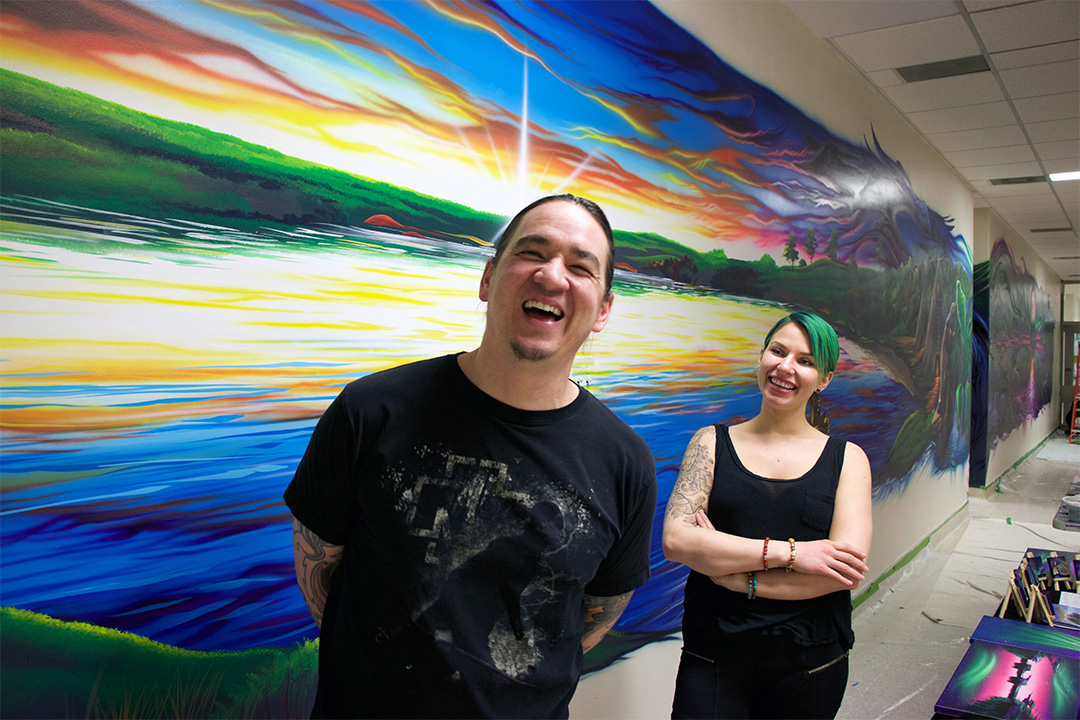
Artists bring Indigenous knowledge to WCVM
An ethereal landscape fills a first-floor hallway at the Western College of Veterinary Medicine (WCVM).
By Jeanette NeufeldAt the far left, a bison greets the sunrise. Animals are woven in throughout the tableau, with a sky that turns from day to night in a swirling bloom of colours.
The busy corridor — typically full of students taking a break from their work at the WCVM Veterinary Medical Centre or rushing to class — has now become a conversation starter as people stop to remark on what used to be a blank wall.
This mural is a work of art by painter Jasyn Lucas and his partner Nicole Brightnose.
The pair travelled from Thompson, Man., where they work as artists and operate an art gallery. Their painting's purpose is to tell a story about Indigenous teachings using the animals that represent those lessons.
"We really wanted to create an interactive mural. We've got people not only just enjoying the imagery, but learning some of the symbolism behind it," says Lucas, explaining that each spirit animal depicted in the mural represents one of the seven sacred grandfather teachings.
The buffalo on the left of the mural represents respect, the turtle stands for truth, the wolf for humility and the eagle for love. The bear represents courage while the beaver stands for wisdom.
One tiny figure is hidden in the trees – this final creature of the seven is not an animal, says Lucas, but a special shapeshifter that can come in several forms. Some know it as sasquatch, but he calls it a Sawbay or Sabe – which stands for honesty. This "trickster" character is a mischievous being that represents unexplained experiences.
"A lot of people have their own meaning, depending on where they're from and their background," says Lucas of his interpretation of the teachings.
"I'm 100 per cent First Nations, but a lot of this stuff I'm just learning for the first time, too," says Lucas, who belongs to the Mathias Colom Cree Nation but grew up with a family of European ancestry in Thompson. He says this bridge between First Nation and settler cultures has given him a unique perspective.
"I consider myself a contemporary Canadian artist who happens to be Aboriginal, Indigenous. I think it does come out in my work. I do have a lot of contemporary ideas that meet traditional influences as well. I try to have a balance of both. I come from both backgrounds," he says.
Lucas began selling art as a kid on the playground, and his adoptive parents encouraged him to pursue his passion. He graduated with a Diploma in Studio Art from Capilano College in Vancouver, B.C., where he developed his own style that blends traditional painting techniques with new methods such as airbrushing.
The mural that Lucas created is part of the WCVM's and the University of Saskatchewan's efforts toward Indigenization and Reconciliation with the Indigenous peoples of Canada. The painting is one step in creating understanding and awareness of Indigenous cultures. In particular, it emphasizes the Indigenous connection to animals – a fitting teaching for the veterinary college.
"It's really great that they have this initiative in place to raise awareness that it is a multicultural place and that some of the teachings we have as Indigenous people are useful," says Lucas.
"The seven sacred teachings, goes back to the animals. You learn from the animals and how they relate to the earth. They teach us a lot," says Brightnose.
Lucas echoes this, noting that Indigenous people traditionally received everything they needed from the land and from animals.
"Each animal had a purpose. They provide different things. Clothing, warmth, medicine, food, shelter. We received everything between the animals and the land. We continue to [receive] to this day, although we tend to forget it," he says.
Lucas says he was honoured to create the mural at the college, and he says it's already sparked lots of questions and conversation during the time he spent creating it.
"If people are talking about it, we've achieved our goal," says Dr. Andy Allen, chair of the WCVM dean's advisory committee on Indigenous engagement.
One creature stands out at the forefront, and while it's not one of the seven teachings, it should hold special meaning for students who spend each day working toward their goals. To Lucas, the colourful butterfly flying across the wall symbolizes transformation, change and evolution – a reminder to continue learning in the process of reconciliation.
"It's a learning experience. Don't be scared to ask questions. Don't be scared to get it wrong," says Lucas.
